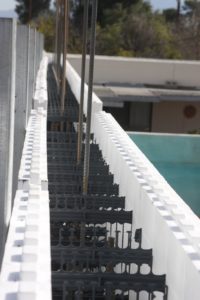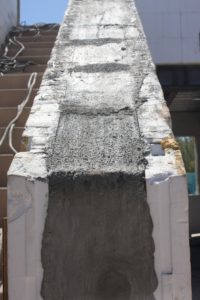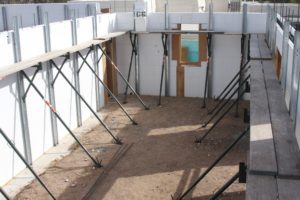Sound Proofing?
Soundproofing does not exist. Nothing really can be made completely sound proof as the name implies. You can not keep all the sound energy at all times, in or out of your room. All you can do is manage the sound energy that originates from outside your room, with certain barrier technologies. Sound energy that originates within our room must be managed using sound absorbing technologies. It is the management of this energy that we must focus upon and the processes involved, not “proofing” anything from sound.
Noise Management
What the name soundproofing really implies is noise management. How much noise do we have to keep out of our rooms and how much energy do we have to keep within our rooms. What frequencies does that noise reside at. What is the amount or amplitude of the noise we wish to manage or keep out or inside of our rooms at these particular frequencies. We must quantify the noise to determine the composition of our barrier. Soundproofing is all about using barriers that are specifically designed to handle the “noise” frequencies between the sound source and the receiver.
Barrier
Barriers differ from each other depending on the frequencies we are trying to keep out of our room. Frequencies below 125 Hz. require different barriers than frequencies above 125 Hz. The material used in the barrier is critical, but it is the density and arrangement of materials that we must concern ourselves with. With barrier technology, we are reducing vibrational energy that is caused by sound pressure waves and rays exerted upon the barrier surfaces. Arranging different materials with different densities in a manner that reduces vibrational energy is the art and science of constructing the proper barrier for the measured noise issues you are faced with.
Barrier Technology
When we live on a noisy street, we must use barrier technology to construct a shield between us and the noise source. This barrier must use vibrational science to minimize the transmission of sound energy from one side of the barrier to the other. If its the bell on some child’s bike that is a concern, then the garbage truck is another issue entirely. Frequencies below 125 Hz. are difficult and the barrier technology required is expensive and can be space consuming because of its required mass and densities. Frequencies above 125 Hz. are much easier to manage.
How Thick ?
To find out what barrier technology we should use, we must first determine how much of what frequency, we need to isolate ourselves from. The child’s bell is of a different frequency range than the garbage truck muffler. It is also of a much larger magnitude in strength. The child’s bike bell can be isolated from completely. All we can hope for with the garbage truck, low frequency, energy is to reduce its impact in our rooms, so that it is below that of the room’s use acceptable noise level. Stopping low frequency noise completely is not an option. We must lower its sonic impact and bring it down below the intended use of the room, so it does not interfere with our sonic objectives of our room.
Sound Transmission Class
STC or sound transmission class rating is an antiquated measure of noise levels and rates from 125 Hz. – 4,000 Hz. It does not measure below 125 Hz., so for any noise that involves frequencies below 125 Hz.,we must look to other units of measure. There is software available that will construct suitable barriers to deal with the energy below 125 Hz. Barriers that impact energy below 125 Hz. are best left to professionals. There is plenty of information for barriers above 125 Hz., but vibrational isolating construction techniques must be followed even with these frequencies.
Vibrations
Barriers are constructed to minimize vibrations. Sound energy from an outside free field source radiates its energy in the forms of waves and rays and this energy travels towards us. It strikes the surface of the barrier we have constructed. To build the appropriate barrier we must use multiple layers of different materials that have different densities. The composition structure of the material and the material’s density, all are considered when we create the barrier.
Vibrational Barriers
Our vibrational goal is to force the wave or ray to have to travel through different “fields” of materials. These materials are arranged in such a manner that based on the vibration’s frequency, they slow the vibration as it travels through our barrier from its originating end, through the barrier, and eventually into our room. Our goal is to reduce the magnitude or strength of the vibration itself by making it travel through a vibrational reducing, “obstacle course”.
Material Density
Maybe we use materials that have densities that are larger for the outside surface of our barrier and work through the barrier construction with materials that have lesser densities. Maybe we start with materials that have lower densities and work through the barrier with materials of larger measured densities. It all depends on what frequency range and how much of each frequency we need to isolate against. Our goal is to reduce the structural vibration’s amplitude so it has less audibility when it converts to an acoustic wavelength.
Noise Management
The use of the term “soundproofing” should be changed to noise management. Clients often use the term without knowing the context into which the term is placed. Their expectations are larger than our current science and in most cases much larger than their budgets. Can we “sound proof” for frequencies above 125 Hz.? Of course, as long as our barrier constructions takes into account the magnitude of the energy we must isolate from. Can we “sound proof” for frequencies below 125 Hz.? The answer depends on which frequencies and how much of them we have to deal with. If we look at frequencies from 125 Hz. down to say 80 Hz., we have a fighting chance, once again, depending on energy strength. Frequencies below 80 Hz. are are a different issue and the term soundproofing and even noise management becomes lacks certain meaning and applicability.
In Summary
If you want to learn more about this subject please sign up for our free room acoustic treatment videos and ebook which provide step by step instructions on all major room acoustic issues. Get instant access by signing up now.
Thanks
Mike








